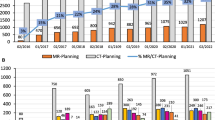Abstract
Background
Intensity modulated radiotherapy (IMRT) is frequently used, but there are no data about current frequency regarding specific tumor sites and equipment used for quality assurance (QA).
Materials and methods
An online survey about IMRT was executed from April to October 2014 by the collaborative IMRT working group (AK IMRT) of the German Association of Medical Physicists (DGMP).
Results
A total of 23 German institutions took part in the survey. Most reports came from users working with Elekta, Varian, and Siemens treatment machines, but also from TomoTherapy and BrainLab. Most frequent IMRT technology was volumetric modulated arc therapy (58.37 %: VMAT/“rapid arc”), followed by step-and-shoot IMRT (14.66 %), dynamic MLC (dMLC: 14.53 %), TomoTherapy (9.25 %), and 3.2 % other techniques. Different commercial hard- and software solutions are available for QA, whereas many institutes still develop their own phantoms. Data of 26,779 patients were included in the survey; 44 % were treated using IMRT techniques. IMRT was most frequently used for anal cancer, (whole) craniospinal irradiation, head and neck cancer, prostate cancer, other tumors in the pelvic region, gynecological tumors (except for breast cancer), and brain tumors.
Discussion
An estimated 10 % of all patients treated in 2014 with radiation in Germany were included in the survey. It is representative for the members of the AK IMRT.
Conclusion
IMRT may be on the way to replace other treatment techniques. However, many scientific questions are still open. In particular, it is unclear when the IMRT technique should not be used.
Zusammenfassung
Hintergrund
Intensitätsmodulierte Bestrahlungstechniken (IMRT) werden oft eingesetzt. Es gibt jedoch keine Daten über deren Häufigkeit in Abhängigkeit von den Tumorentitäten und welche Geräte für die Qualitätssicherung (QA) zum Einsatz kommen.
Materialien und Methoden
Der Arbeitskreis IMRT (AK IMRT) der Deutschen Gesellschaft für Medizinische Physik (DGMP) hat von April bis Oktober 2014 eine Online-Umfrage zu diesem Themenbereich durchgeführt.
Ergebnisse
An der Umfrage haben 23 deutsche strahlentherapeutische Einrichtungen teilgenommen. Am häufigsten wurden Therapiegeräte von Elekta, Varian und Siemens angegeben. Ebenso auch Geräte von TomoTherapy, BrainLab und anderen Firmen. Mit 58,37 % waren die volumenmodulierten Rotationstechniken (VMAT/“rapid arc”) am häufigsten, gefolgt von “step-and-shoot”-IMRT (14,66 %), dynamischem MLC (dMLC: 14,53%), TomoTherapy (9,25 %) und 3,2 % anderen Techniken. Meist werden kommerzielle Produkte für die QA eingesetzt, viele Einrichtungen bauen jedoch noch eigene Prüfkörper. Es wurden die Daten von 26.779 Patienten in die Umfrage eingebracht. Eine IMRT bekamen 44 % aller Patienten. Mehrheitlich wurde IMRT bei folgenden Tumorentitäten eingesetzt: Analkarzinomen, kraniospinalen Bestrahlungen, Kopf-Hals-Tumoren, Prostatakarzinomen, anderen Tumoren im Beckenbereich, gynäkologischen Tumoren (ohne Mammakarzinome) und Hirntumoren.
Diskussion
Geschätzte 10 % aller Patienten, die pro Jahr in Deutschland bestrahlt werden, sind in diese Umfrage eingegangen. Sie ist repräsentativ für die Mitglieder des AK IMRT.
Schlussfolgerung
Die IMRT verdrängt andere Bestrahlungstechniken. Wissenschaftliche Fragestellungen hierzu sind jedoch noch offen. Insbesondere ist unklar, wann keine IMRT-Techniken eingesetzt werden sollten.





Similar content being viewed by others
References
AK IMRT der DGMP and der DEGRO. www.uke.de/extern/akimrt/IMRT_Startseite.htm. Accessed 12 March 2015
Leitlinie zur Strahlentherapie mit fluenzmodulierten Feldern (IMRT) (2005) www.degro.org. Accessed 12 March 2015
Popple RA, Balter PA (2014) Because of the advantages of rotational techniques, conventional IMRT will soon become obsolete. Med Phys 41:100601
Dunst J, Willich N, Sack H, Engenhart-Cabillic R, Budach V, Popp W (2014) The QUIRO Study (assurance of quality and innovation in radiooncology): methodology, instruments and practices. Strahlenther Onkol 190:138–148
Gao K, Ding L, Li L (2014) Analysis of clinical efficacy of intensity-modulated radiation therapy and the prognosis factors in advanced cervical cancer. Zhonghua Fu Chan Ke Za Zhi 49:30–35
Gandaglia G, Karakiewicz PI, Briganti A, Trinh QD, Schiffmann J, Tian Z et al (2014) Intensity-modulated radiation therapy leads to survival benefit only in patients with high-risk prostate cancer: a population-based study. Ann Oncol 25:979–986
Jang-Chun L, Jing-Min H, Yee-Min J, Dai-Wei L, Chang-Ming C, Chun-Shu L et al (2014) Comparisons of quality of life for patients with nasopharyngeal carcinoma after treatment with different RT technologies. Acta Otorhinolaryngol Ital 34:241–246
Nutting CM, Morden JP, Harrington KJ, Urbano TG, Bhide SA, Clark C et al (2011) Parotid-sparing intensity modulated versus conventional radiotherapy in head and neck cancer (PARSPORT): a phase 3 multicentre randomised controlled trial. Lancet Oncol 12:127–136
Tribius S, Bergelt C (2011) Intensity-modulated radiotherapy versus conventional and 3D conformal radiotherapy in patients with head and neck cancer: is there a worthwhile quality of life gain? Cancer Treat Rev 37:511–519
Acknowledgments
We would like to thank following colleagues participating the online IMRT survey:
Dr. rer. nat. Wolfgang Baus (Köln)
Dipl.-Ing. Ute Birkenhagen (Pinneberg)
Dr. Eyck Blank (Neuruppin)
Dipl.-Phys. Mathias Dierl (Bayreuth)
Dr. Jörg Eckardt (Bochum)
Dr. Niels Götting (Berlin)
Dr.-Ing. Daniel Hummel (Stuttgart)
Dr. rer. nat. Thomas Koch (Bamberg)
Dr. rer. nat. Ulrike Lambrecht (Erlangen)
Prof. Dr. Frank Lohr (Mannheim)
Dipl.-Phys. Torsten Peil (Halle/Saale)
Dipl.-Ing. (FH) Mathias Pfaender (Berlin)
Dipl.-Phys. Marcel Renz (Braunschweig)
Dipl.-Ing. Bjørne Riis (Lübeck)
Dipl.-Phys. Steffen Rocjor (Cottbus)
Dr. Nada Schmidt-Petersen (Stade)
PD Dr. Florian Sterzing (Heidelberg)
Dipl.-Ing. Sophie Taubner (Nürnberg)
M. Sc.. Stefan Waurig (Fürth)
Prof. Dr. Ulrich Wolf (Leipzig)
We also thank two colleagues who participated anonymously.
Author information
Authors and Affiliations
Corresponding author
Ethics declarations
Conflict of interest
T. Frenzel and A. Krüll state that there are no conflicts of interest.
The accompanying manuscript does not include studies on humans or animals.
Rights and permissions
About this article
Cite this article
Frenzel, T., Krüll, A. The use of IMRT in Germany. Strahlenther Onkol 191, 821–826 (2015). https://doi.org/10.1007/s00066-015-0832-4
Received:
Accepted:
Published:
Issue Date:
DOI: https://doi.org/10.1007/s00066-015-0832-4
Keywords
- Radiotherapy, intensity-modulated
- Guideline
- German Society for Radiation Oncology (DEGRO)
- German Society of Medical Physicists (DGMP)
- Survey




